[another of those pieces written for the book on sf adaptations that never appeared]
Narrated from the perspective of the doctors treating him, particularly psychiatrist Janet Ross, Crichton’s novel tells the story of divorced, thirtysomething computer scientist, Harold Benson. He suffers from blackouts during which he becomes extremely violent. Since orthodox medication has no effect on his Acute Disinhibitory Lesion (ADL) syndrome, he agrees to a radical surgical procedure, conducted by the Neuropsychiatric Research Unit (NRU). Forty electrodes are inserted into the damaged section of his brain and a nuclear powerpack into his shoulder. A computer implanted in his neck will detect the onset of a seizure and abort it with a shock through one of the electrodes. Ross considers Benson, who believes that machines are ‘competing with human beings’ and will ‘ultimately … take over the world’ (15), an unsuitable candidate for this procedure. Professor Manon is also opposed to the operation since it will do nothing to cure Benson’s psychosis, but the ambitious Dr Ellis justifies his decision to proceed on the grounds that it will at least stop Benson’s seizures and the accompanying violence. On the eve of the operation, a young woman called Angela Black visits Benson.
After the operation, Roger McPherson, head of the NRU, is troubled by Benson’s continued conviction about the machine threat. Monitoring Benson’s brain activity, Ross notices the increasing frequency of stimulations as he starts to ‘initiate seizures in order to experience the pleasurable shocks’ (131). Benson escapes from the hospital. A computer projection indicates that within hours he will be receiving almost continuous stimulations, making 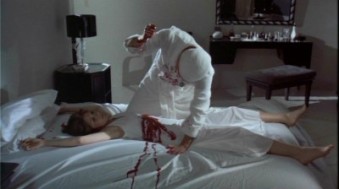 him uncontrollably violent. The medical staff set out to find him. Shortly after the tipping-point passes, Angela is found murdered, her skull crushed and her body repeatedly stabbed post-mortem.
him uncontrollably violent. The medical staff set out to find him. Shortly after the tipping-point passes, Angela is found murdered, her skull crushed and her body repeatedly stabbed post-mortem.
When Benson attacks Ross in her home, she uses her microwave to disrupt his powerpack, but Dr Morris, who tracks him to a hangar, is brutally beaten. While Ellis spins the story for the media, the LAPD’s Captain Anders discovers that Benson obtained plans for the hospital’s wiring system. Ross and Anders descend into the labyrinthine basement housing the hospital’s mainframe, and when Benson attemps to destroy it, Ross shoots him dead.
The selection of Mike Hodges – director of the quintessential British neo-noir Get Carter (1971) and the self-reflexive black crime comedy Pulp (1972) – to adapt Crichton’s novel might seem a curious choice. However, even if Hodges’ background in documentary (including ITV’s hard-hitting current affairs series World in Action (1963–99) in the early 1960s) had not recommended him for the project, it certainly assisted him in crafting the most aesthetically (and least financially) successful Crichton adaptation. Crichton uses various techniques in an attempt to lend his potboiler a kind of documentary realism, including: the same title format for each chapter (e.g., ‘WEDNESDAY, MARCH 10, 1971: Implantation’); a timeline of the history of psychosurgical therapy, culminating in an entry which reads ‘Harold Benson is operated on in Los Angeles’ (the October 23 1971 date of this introduction, like the chapter titles, implies that the novel is a record of something that has already happened); sundry computer outputs; facsimiles of LAPD crime and death reports; and a six-page bibliography. While Hodges’ documentarian skills might suit him to these and related aspects of the novel, his black humour and leftist political sensibilities are utterly at odds with Crichton’s distinctive reactionary blend of moralistic earnestness and hysterical technophobia.
Crichton presents his novel as a cautionary intervention into technoscientific developments and the failure of a purportedly democratic system to foster informed popular debate about key social issues and trends. Whatever degree of hucksterism this involves, it is presented as a genuine concern. However, although the novel does evoke concerns around the dehumanising potentials of technology, it fails to articulate a coherent position in relation to them. This ideological fuzziness, typical of Crichton’s work, may in part account for his phenomenal success.
The key contradiction shaping the novel is between linear and non-linear determinism, articulated through a dislike and simultaneous embrace of authoritarian structures, and through an equally muddled championing of individualism and moralistic disdain for the ways in which certain people ‘misuse’ their freedom. Crichton’s reactionary leanings often take on a pseudo-pragmatic, anti-intellectual, anti-big government tone (for example, substantial passages are devoted to characters arguing that violent behaviour results from physical brain damage, while no-one even contemplates any of the other potential causes suggested in all the ‘bad theory floating around, written by sociologists and paid for by good taxpayer money’ (41)), which completely contradicts his growing awareness of complex determinism.
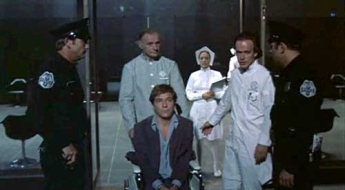 When Benson arrives at the hospital, Morris signs for him ‘as if he were receiving a package from United Parcel’ (8), a subjection to bureaucratic processes that resonates with the patient’s psychosis. McPherson later suggests that Benson has been turned into ‘a read-out device’ for the implanted computer, ‘as helpless to control the read-out as a TV screen is helpless to control the information presented on it’ (83; italics in original). The hospital computer refers to Benson as an ‘auxillary unit’ (120), while he describes himself as ‘an automobile in a complicated service station’ (125). Morris begrudges his pager, which keeps him perpetually networked into administrative systems, and at one point suddenly notices that computers monitor and predict LA traffic flows. Such ruminations are given a sense of inevitable – and detrimental – consequence through the linear determinism espoused by several characters and by the frequency with which futurological and computer projections are treated as inarguable: in 1967, McPherson surveyed the fields of ‘diagnostic conceptualization, surgical technology, and microelectronics’ and concluded that it would be possible to perform ‘an operation for ADL seizures in July of 1971’ (197), a prediction which proved too conservative by four months; and the positive progression cycle, in which Benson’s brain learns to trigger seizures, is plotted from just three points on a graph, predicting to within a couple of minutes when he will go into continuous stimulation. Consequently, when Morris is told about July 1969’s ‘Watershed Week’ – ‘when the information-handling capacity of all the computers in the world exceeded the information-handling capacity of all the human brains in the world’ – and that by 1975 computers will ‘lead human beings by fifty to one in terms of capacity’ (159-60), the novel succeeds in conveying a sense of menace. This is achieved by conflating a not unreasonable prediction of quantitative change with the implication that it must necessarily result in a threat to humanity – or at least to our human qualities (which consist entirely of small-town, middle-American values).
When Benson arrives at the hospital, Morris signs for him ‘as if he were receiving a package from United Parcel’ (8), a subjection to bureaucratic processes that resonates with the patient’s psychosis. McPherson later suggests that Benson has been turned into ‘a read-out device’ for the implanted computer, ‘as helpless to control the read-out as a TV screen is helpless to control the information presented on it’ (83; italics in original). The hospital computer refers to Benson as an ‘auxillary unit’ (120), while he describes himself as ‘an automobile in a complicated service station’ (125). Morris begrudges his pager, which keeps him perpetually networked into administrative systems, and at one point suddenly notices that computers monitor and predict LA traffic flows. Such ruminations are given a sense of inevitable – and detrimental – consequence through the linear determinism espoused by several characters and by the frequency with which futurological and computer projections are treated as inarguable: in 1967, McPherson surveyed the fields of ‘diagnostic conceptualization, surgical technology, and microelectronics’ and concluded that it would be possible to perform ‘an operation for ADL seizures in July of 1971’ (197), a prediction which proved too conservative by four months; and the positive progression cycle, in which Benson’s brain learns to trigger seizures, is plotted from just three points on a graph, predicting to within a couple of minutes when he will go into continuous stimulation. Consequently, when Morris is told about July 1969’s ‘Watershed Week’ – ‘when the information-handling capacity of all the computers in the world exceeded the information-handling capacity of all the human brains in the world’ – and that by 1975 computers will ‘lead human beings by fifty to one in terms of capacity’ (159-60), the novel succeeds in conveying a sense of menace. This is achieved by conflating a not unreasonable prediction of quantitative change with the implication that it must necessarily result in a threat to humanity – or at least to our human qualities (which consist entirely of small-town, middle-American values).
Such linear determinism seeps out into Crichton’s depiction of a dehumanised social world. As Ross drives around LA, she muses upon the ways in which an automobile-dominated culture ‘thwarted some deep human need to congregate, to be together, to see and be seen’ (147), producing a depersonalized society of ‘recent emigrants and therefore strangers’ (147) who lack traditional institutions and infrastructures. LA offers ‘freedom’, but no ‘supports’, and tends to attract ‘people with problems’ (148), a euphemism for homosexuals, who are equated in the same passage with loneliness and suicide. The novel’s homophobia is striking (for example, Ross bemoans a short-lease culture which results in apartment buildings ‘full of hookers, full of gays, full of drugs and transients’ (171)), implying that any alternative to heterosexuality is a form of deviance born of dehumanising modernity.
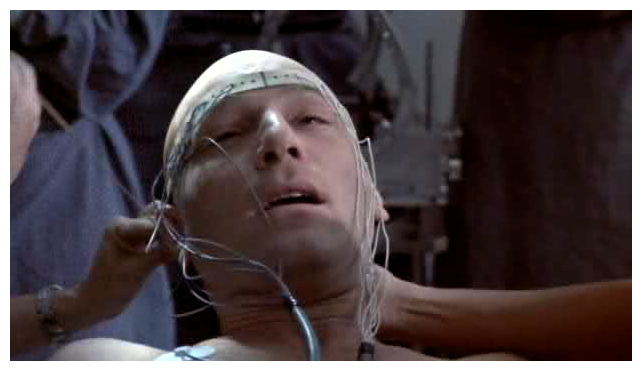 Curiously, though, Crichton also struggles at times to express a sense of the complex, non-linear determinism underpinning his trademark narrative about the failure of complex systems, best – if still rather clumsily – articulated through the chaos mathematics he invokes in Jurassic Park (1990). In The Terminal Man, it is most clearly developed through Gerhard’s computer programmes, called Saint George and Martha. Designed to interact with each other, they are capable of responding ‘with three emotional states – love, fear, and anger’ and of ‘produc[ing] three actions – approach, withdrawal, attack’ (99). Despite this system’s simplicity, it ‘produce[s] complex and unpredictable machine behavior’ (115). After running more than a hundred times, Saint George, ‘programmed for saintliness’, ‘is learning not be a saint around Martha’ (103), even threatening to kill her. This is presented as a value-neutral experiment, but the obvious gender stereotyping suggests that the dependence on initial conditions need not be that sensitive to produce this result. The implications of a later discussion, in which Gerhard and Ross contemplate the possibility that after twenty-four hours of stimulations Benson’s brain has become something radically different than the one on which they operated and thus beyond their capacity to predict, are likewise countered by the utter predictability of the plot.
Curiously, though, Crichton also struggles at times to express a sense of the complex, non-linear determinism underpinning his trademark narrative about the failure of complex systems, best – if still rather clumsily – articulated through the chaos mathematics he invokes in Jurassic Park (1990). In The Terminal Man, it is most clearly developed through Gerhard’s computer programmes, called Saint George and Martha. Designed to interact with each other, they are capable of responding ‘with three emotional states – love, fear, and anger’ and of ‘produc[ing] three actions – approach, withdrawal, attack’ (99). Despite this system’s simplicity, it ‘produce[s] complex and unpredictable machine behavior’ (115). After running more than a hundred times, Saint George, ‘programmed for saintliness’, ‘is learning not be a saint around Martha’ (103), even threatening to kill her. This is presented as a value-neutral experiment, but the obvious gender stereotyping suggests that the dependence on initial conditions need not be that sensitive to produce this result. The implications of a later discussion, in which Gerhard and Ross contemplate the possibility that after twenty-four hours of stimulations Benson’s brain has become something radically different than the one on which they operated and thus beyond their capacity to predict, are likewise countered by the utter predictability of the plot.
A generous reader might construe the material about Saint George and Martha as Crichton’s commentary on his own deployment of blandly named, more or less indistinguishable characters. One might even see such characters, typical of Crichton’s fiction, as an elaboration upon his screeds against the anonymity of modern, urban life while working within an American popular fiction idiom which privileges the description of externalities from which the reader is to infer interiorities. However, Crichton does describe several characters’ interior lives, albeit perfunctorily, and just as the novel reads like the treatment for a screenplay, these formulaic passages seem like notes for the actors who might step in and bring them to life. A more conventional adaptation would undoubtedly have sought to animate them through the verisimilar and melodramatic strategies typical of Hollywood productions (such as Crichton himself deployed, with some success, in adapting Robin Cook’s Coma (1977) in 1978), but Hodges takes a rather different path. He transforms Crichton’s dyspeptic, incoherent jeremiad into a rigorous critique of totalizing institutions (here, medicine, combined with legal and penal systems, as well as the police and patriarchy) which can be understood as modelling the deeper logic of social, political and economic structures governing everyday life – like One Flew Over the Cuckoo’s Nest (Forman 1975), but without its sentimental desire for heroism and redemption.
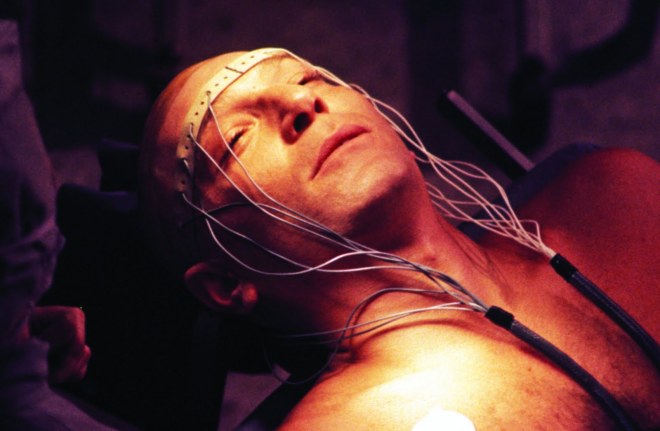 The film opens in pitch black night, the only light emanating from the cockpit of an insectile police helicopter facing the camera, the only noise that of its engines as it takes to the air; the helicopter will become an aggressively loud presence, signalling the powerlessness not merely of Benson (George Segal) to avoid it but of the audience in the face of the system it represents. The film cuts to a restaurant, in which doctors Ellis (Richard Dysart), McPherson (Donald Moffat) and Friedman (James Sikking) discuss Benson and ADL syndrome. Benson’s back-story is related, with impressive economy, through a series of photographs that the three men examine – Benson with his wife and daughter, Benson being arrested, the battered face of Benson’s wife – while planning the media coverage of the operation. To Hodges’ regret, he added this sequence to help allay studio concerns that ‘the film had no one to root for’ (personal email) rather than cutting
The film opens in pitch black night, the only light emanating from the cockpit of an insectile police helicopter facing the camera, the only noise that of its engines as it takes to the air; the helicopter will become an aggressively loud presence, signalling the powerlessness not merely of Benson (George Segal) to avoid it but of the audience in the face of the system it represents. The film cuts to a restaurant, in which doctors Ellis (Richard Dysart), McPherson (Donald Moffat) and Friedman (James Sikking) discuss Benson and ADL syndrome. Benson’s back-story is related, with impressive economy, through a series of photographs that the three men examine – Benson with his wife and daughter, Benson being arrested, the battered face of Benson’s wife – while planning the media coverage of the operation. To Hodges’ regret, he added this sequence to help allay studio concerns that ‘the film had no one to root for’ (personal email) rather than cutting 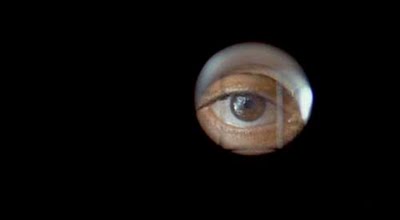 directly to the title sequence: a black screen with white credits, accompanied by Glenn Gould’s performance of Bach’s Goldberg Variation No. 25; footsteps approach in a corridor; a key chain rattles; there is a scraping sound, a peephole opens on the right of the screen and an eye peers through, looking out at the audience; the men in the corridor, functionaries of some institution, discuss Benson; the caption ‘tuesday’ appears, and the film cuts to Benson being delivered by the police to the hospital. Three more times during the film the screen goes to black, a peephole opens, and these anonymous, uneducated men – it is not clear if they are prison warders or asylum orderlies – discuss Benson. The film also ends with a version of this shot, in which one of the voices says, ‘They want you next’, to which the other responds ‘Quit kidding around’. These final words comically deflate the clichéd threat intoned by the first speaker; but beneath the end credits, the police helicopter descends through the night, coming full circle, yet instead of the deafening rotors there is silence, and then a cold wind howls. This hesitation – erasing then reinstating the film’s ominous implications – indicate Hodges’ wry amusement at the materials with which he is working and, simultaneously, a genuine sense that, despite their pulpiness, they can be utilised to critique contemporary social realities.
directly to the title sequence: a black screen with white credits, accompanied by Glenn Gould’s performance of Bach’s Goldberg Variation No. 25; footsteps approach in a corridor; a key chain rattles; there is a scraping sound, a peephole opens on the right of the screen and an eye peers through, looking out at the audience; the men in the corridor, functionaries of some institution, discuss Benson; the caption ‘tuesday’ appears, and the film cuts to Benson being delivered by the police to the hospital. Three more times during the film the screen goes to black, a peephole opens, and these anonymous, uneducated men – it is not clear if they are prison warders or asylum orderlies – discuss Benson. The film also ends with a version of this shot, in which one of the voices says, ‘They want you next’, to which the other responds ‘Quit kidding around’. These final words comically deflate the clichéd threat intoned by the first speaker; but beneath the end credits, the police helicopter descends through the night, coming full circle, yet instead of the deafening rotors there is silence, and then a cold wind howls. This hesitation – erasing then reinstating the film’s ominous implications – indicate Hodges’ wry amusement at the materials with which he is working and, simultaneously, a genuine sense that, despite their pulpiness, they can be utilised to critique contemporary social realities.
Hodges’ damning depiction of the total institution depends upon four major strategies. First, there is the film’s remarkable production design, in particular its use of colour. The title sequence establishes The Terminal Man’s oppressive palette; it is as close as a colour film can get to a black-and-white production, with several shots among the most overtly expressionist to be found in Hollywood outside of classical film noir. The walls, floor and furniture of the hospital lobby are black, and its windows open onto utter darkness outside. Throughout the hospital, if walls are white, then doors and furnishings are black. The staff all wear white, except for when, off-duty, they wear black. If there is a source of light, everything around it is pooled in darkness. The only relief – slight that it is – comes from occasional blue-greys or flashing orange lights. Until the final stages of the film, there is no indication that daytime even exists, but once we are there, bright clear light and whiteness – from the walls of Dr Ross’s (Joan Hackett) apartment to Benson’s choice of suit – dominate, although black furnishings remind the audience of the night to come. Day or night, there is no escape from these carefully orchestrated constraints.
Second, there is Hodges’ meticulous shot-construction, perhaps the most significant aspect of which is his frequent partial obscuring of Ross. Marginalised by the medical establishment for being a woman, a psychiatrist (rather than a surgeon), and more concerned about the patient than the procedure, Ross is often pushed by Hodges to the edge of the frame or picked out, diminished in the distance, from between foregrounded 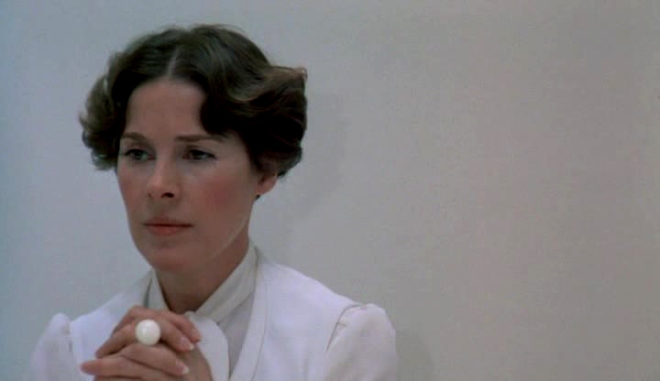 surgeons. While Crichton does acknowledge the sexism Ross faces, including incidents and passages of introspection, Hodges’ low-key spatialisation of patriarchal hegemony is far more effective. This spatialisation of gendered power is further emphasised during the sequence in which Ross’s discomfiture, when alone with Benson during the testing of his electrodes, is ignored by the male doctors observing them through one-way glass positioned high on the wall above them. The Foucauldian aspects of commonplace surveillance are even more clearly evinced during the lengthy surgical procedurals – articulated through an impeccable low-key precision, self-consciously devoid of the melodramatic imperatives shaping such sequences in Crichton’s E.R. (1994–2009) – as a crowd gathers around to observe the operation from above.
surgeons. While Crichton does acknowledge the sexism Ross faces, including incidents and passages of introspection, Hodges’ low-key spatialisation of patriarchal hegemony is far more effective. This spatialisation of gendered power is further emphasised during the sequence in which Ross’s discomfiture, when alone with Benson during the testing of his electrodes, is ignored by the male doctors observing them through one-way glass positioned high on the wall above them. The Foucauldian aspects of commonplace surveillance are even more clearly evinced during the lengthy surgical procedurals – articulated through an impeccable low-key precision, self-consciously devoid of the melodramatic imperatives shaping such sequences in Crichton’s E.R. (1994–2009) – as a crowd gathers around to observe the operation from above.
Third, there are the performances. Joan Hackett’s self-conscious awkwardness as Ross is essential to the critique of gender politics. The very different physiques, looks, mannerisms and accents of Richard Dysart, Donald Moffat and, as Dr Morris, Michael C. Gwynne provide a clearer sense of differentiation between the senior medical staff than can be found in Crichton’s novel, but Hodges does not permit them to become more than components of the systems within which they function. An occasional line or gesture suggests that they are fuller human beings than their social roles allow, but such moments (for example, Ellis’s off-colour comment to McPherson about Ross, or Morris’ attempt to 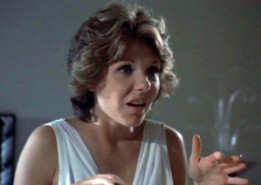 flirt with Angela (Jill Clayburgh)) seem to bemuse the other characters. Retrospectively, George Segal seems an unlikely Benson. Despite a successful career as a dramatic actor on stage, television and film, by the early 1970s he was focusing on the kind of comedy roles with which he has subsequently become most closely associated. By effectively casting him against type, Hodges produces a soft-spoken, genial everyman who is overtaken by external forces (the pre-credits material is, indeed, a misstep, giving Benson too much specificity, and counteracting the effectiveness of a later scene in which a recording of his litany of suburban lifestyle elements and possessions plays on multiple diegetic screens). He is particularly effective when his actions – stabbing Angela, attacking the robot on which he had been working – become mechanical, taking control of his body.
flirt with Angela (Jill Clayburgh)) seem to bemuse the other characters. Retrospectively, George Segal seems an unlikely Benson. Despite a successful career as a dramatic actor on stage, television and film, by the early 1970s he was focusing on the kind of comedy roles with which he has subsequently become most closely associated. By effectively casting him against type, Hodges produces a soft-spoken, genial everyman who is overtaken by external forces (the pre-credits material is, indeed, a misstep, giving Benson too much specificity, and counteracting the effectiveness of a later scene in which a recording of his litany of suburban lifestyle elements and possessions plays on multiple diegetic screens). He is particularly effective when his actions – stabbing Angela, attacking the robot on which he had been working – become mechanical, taking control of his body.
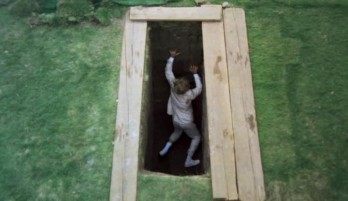 Finally, there is the revised ending of the story. Rather than seeing off Benson’s attack with her microwave, Ross, fearing he might attack her, holds out a knife towards him. In a moment of lucidity between stimulations, he walks onto the blade. Instead of launching an assault on the hospital computer, Benson then heads to a cemetery and descends into an open grave. The police close in and while Ross struggles to reach her patient, the police helicopter appears once more, bearing the sniper who will shoot Benson. People rush forward, and from the bottom of the grave we see them forced back by police whose vizored helmets recall not only those worn by the surgeons while they operated on Benson but also the brutally anonymous robot police of THX 1138 (Lucas 1971).
Finally, there is the revised ending of the story. Rather than seeing off Benson’s attack with her microwave, Ross, fearing he might attack her, holds out a knife towards him. In a moment of lucidity between stimulations, he walks onto the blade. Instead of launching an assault on the hospital computer, Benson then heads to a cemetery and descends into an open grave. The police close in and while Ross struggles to reach her patient, the police helicopter appears once more, bearing the sniper who will shoot Benson. People rush forward, and from the bottom of the grave we see them forced back by police whose vizored helmets recall not only those worn by the surgeons while they operated on Benson but also the brutally anonymous robot police of THX 1138 (Lucas 1971).
Thanks to Hodges’ stylistic innovations, The Terminal Man should be spoken of in the same breath as other films of the period in which Britons brought a European arthouse sensibility to American genre fiction, such as Point Blank (Boorman 1967) and The Man Who Fell To Earth (Roeg 1976). In terms of its political critique, however, it belongs alongside Medium Cool (Wexler 1969), Punishment Park (Watkins 1971), The Parallax View (Pakula 1974) and The Conversation (Coppola 1974). It is without question one of the most accomplished and important sf films of the 1970s.
References
Michael Crichton, The Terminal Man. London: Arrow, 1996.
Mike Hodges, personal email. 5 July 2009.






This is great! I just heard of this film a couple days ago! I’m going to have to check it out. V
LikeLike